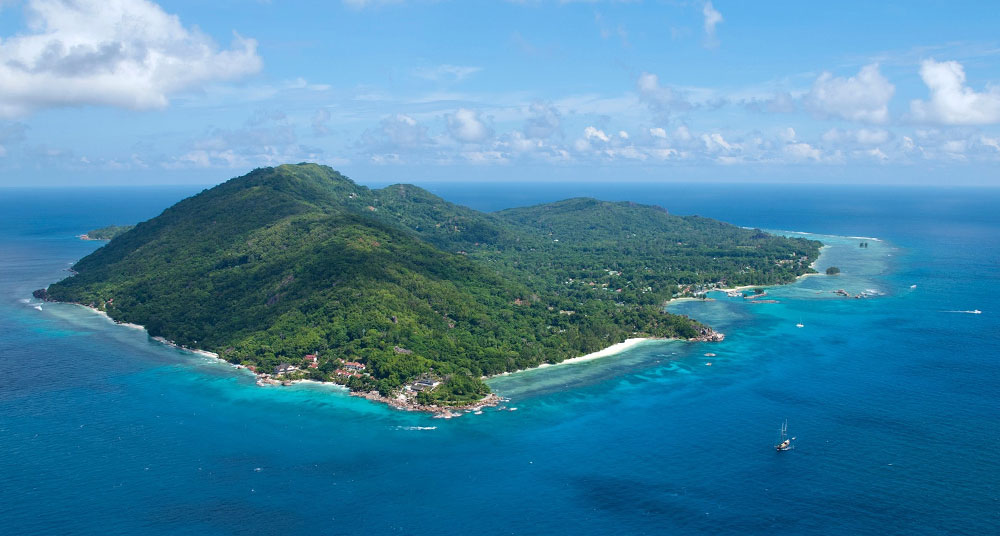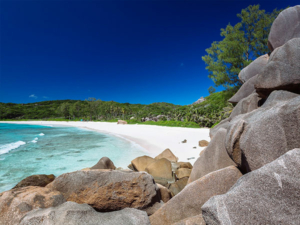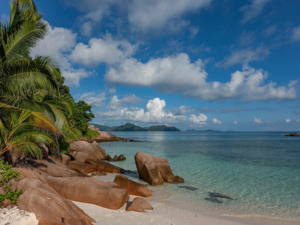La Digue Island
La Digue is a small tropical main island in the heart of the Seychelles
La Digue in Seychelles is the ideal destination to visit if you’re searching for a laid-back island ambiance with stunning beaches and a taste of native life. The smallest of the three inhabited islands, La Digue, has a population of only 2,000 people. With no airport and only a few road cars, this is a very laid-back destination with some of Seychelles’ most well-known beaches.
It is feasible to visit La Digue on a day excursion from Mahe or Praslin, but to fully appreciate the atmosphere and explore the island, you need to remain for several days.
All tourists to La Digue finish up in the settlement of La Passe on the island’s east coast, where they may take in a breathtaking view of Praslin across the water. The village is spread out, requiring around ten minutes to pedal from one location to the next, yet it is still a village.
While the town’s beaches provide beautiful views of Praslin, they are far from the most spectacular or greatest swimming beaches on the island.
Table of Contents:
– La Digue Island
– Getting around
– Beaches
– Attractions
– Conclusion
– Videos
Getting around La Digue
All you have to do to go about La Digue is hop on a bike and go wherever you want! Bikes are frequently provided free of charge by your accommodation, but if not, there are a number of bike rental shops in town. Child seats and bicycles for children are available, albeit in limited quantities. If you’re traveling with children, it’s a good idea to contact your hotel ahead of time to save time.
It is easy to ride through town to visit Anse Source D’Argent because the roads are flat, but you will need to bring plenty of puff or allow additional time to explore Grande Anse, Anse Severe, or any of the beaches on the east coast because the roads are steep. The shortest route to Anse Severe is from the town center, and it may be done on foot.
Unfortunately, the iconic ox-carts are falling out of favor, though you may still see one or two in town, and the roads are no longer dirt tracks. Thankfully, the government chose to pave rather than asphalt the road in town, and the paths up the hill and along the seaside are now concrete.
There are only a few cabs on the island, and the costs are pretty high for a short journey – but you’re probably simply going from your hotel to the dock or vice versa, so it’s not a big deal. Taxis can be rented for half-day or full-day trips to go about.
Many hotels provide a transfer service to the jetty, and they usually pick up visitors in an electric buggy, which is a great concept because it reduces the number of motor cars on the road.
The beaches of La Digue
At least one of La Digue beach makes it every year to the top 10 beaches in the world.
La Digue’s beaches are not to be missed. It’s no surprise that they’re frequently referred to as some of the world’s most beautiful beaches, and they never fail to impress. These beaches will steal your breath away, whether you like the vast sweeping stretches of spotless white sand in the south or the stunning Anse Source d’Argent, which is framed by massive granite boulders.
Surprisingly, despite their breathtaking beauty, these are not the best bathing beaches in Seychelles or La Digue. The beaches on the west coast, such as La Passe and La Reunion, as well as the famous Anse Source d’Argent, have very shallow waters.
Large waves sweep in from across the Indian Ocean at the wild and spectacular Grande & Petite Anse, as well as the lovely Anse Cocos on the south coast, with a strong undercurrent that makes swimming dangerous. Anse Cocos has a natural lagoon built by granite cliffs that provide tranquil bathing waters.
The east coast after Anse Patates is wild and lovely, but not suitable for swimming. If you’re not used to cycling, the large hills between the bays make it a strenuous ride – you could easily spend four hours cycling from town to Anse Fourmis and back without stopping – but if you want to explore a rugged coastline, it’s a nice change from the pristine bays found elsewhere in Seychelles.
Some of the beaches in the far south-east and south-west require a short stroll along well-hidden pathways, and a few are so remote that only a guide can get you there. Regardless of how daring you are, it is best to get local counsel before attempting to locate them – tourists have been known to get lost for days in the jungle-covered highlands.
La Digue
Grand Anse
La Digue
Anse Severe
La Digue Attractions
La Veuve” Reserve
We see the last of the Seychelles Paradise Flycatchers (or Black Widow) on La Digue, a bird that is mostly found in the “La Veuve” Reserve constructed specifically for it. On La Digue Island in 2012, there were an estimated 300 black widows. The reserve is located near La Réunion’s village.
The site is open to the public for free, however, donations are appreciated! An information center explains how the reserve works and what life is like for the Black Widows. The paths in the reserve are easy to follow and level. It is not an enclosure, but rather a virtual forest barrier with multiple entrance points. We were able to see some Black Widows by chance and by looking closely.
Union Estate
South of La Passe and Anse Reunion is the Union Estate. It is a tourist and historical estate with various attractions. A cemetery where the island’s earliest settlers are buried; a traditional copra mill powered by an ox, using an ancient process to extract the precious and valuable coconut oil; and many small stores selling coconut oil and other items are among the island’s tourist attractions.
The area is bordered by various types of gardens and plants. The “Plantation House” is a colonial home that served as the backdrop for the production of “Emmanuelle.” A big enclosure with enormous land turtles is also available.
La Digue Facts
La Digue is the fourth largest island in Seychelles and is known for its stunning beaches and laid-back atmosphere. Here are some quick facts about La Digue Island:
- Population: Approximately 2,000 people live on La Digue Island.
- Size: La Digue Island is approximately 10.5 square kilometers (4 square miles) in size.
- Transportation: The main mode of transportation on La Digue Island is by bicycle or oxcart.
- Beaches: The island is home to some of the most beautiful beaches in Seychelles, including Anse Source d’Argent and Anse Severe.
- Activities: Visitors to La Digue Island can enjoy snorkeling, diving, fishing, and hiking, as well as visits to the island’s many landmarks, such as the Veuve Reserve and the L’Union Estate.
- Climate: La Digue Island has a tropical climate, with average temperatures ranging from the mid-70s to the low-80s Fahrenheit (24-29 degrees Celsius) year-round.
- Language: The official language of La Digue Island is English, though French and Seychellois Creole are also widely spoken.
Conclusion
Our expert opinion of La Digue Island
La Digue is a laid-back tiny island known for its beaches, which include white sand and unique granite rocks, making it ideal for a beach vacation.
The majority of visitors to La Digue arrive by one of two ferries from Mahè or Praslin Island. Every day, there are multiple connections.
You can alternatively take a helicopter transport and land at La Digue’s modest, picturesque helipad near the L’Union natural reserve if you prefer a short trip.
Videos La Digue Island
Best videos on La Digue Island





